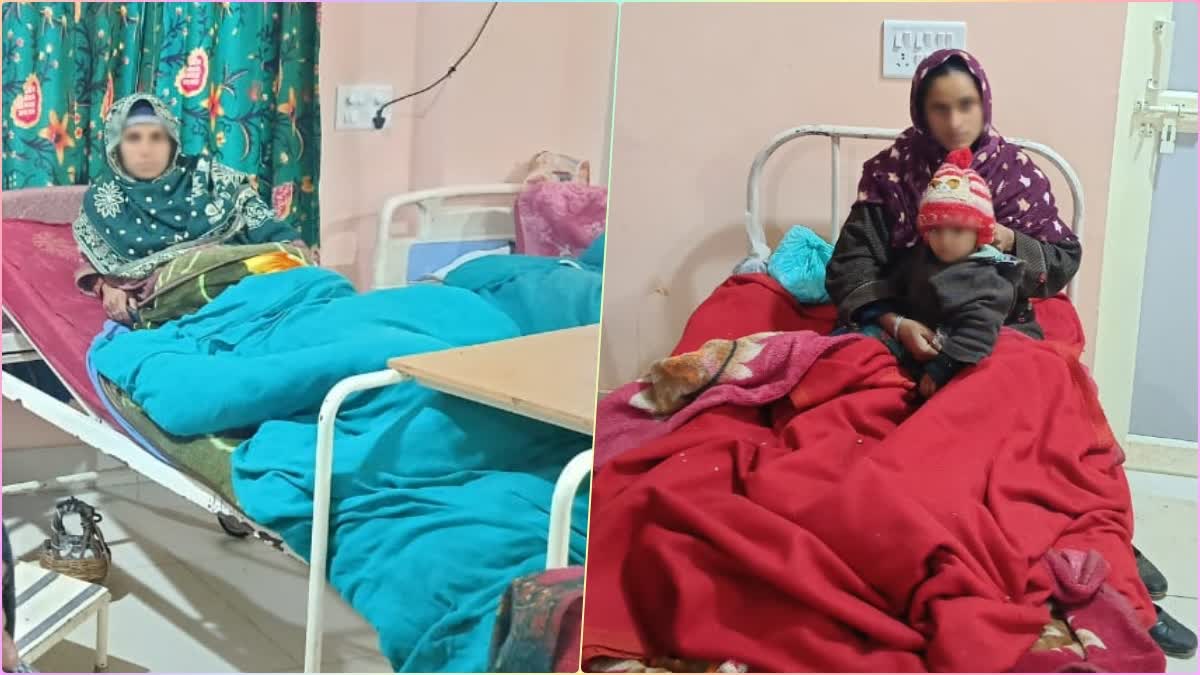Srinagar: As the winter ushers snow in Kashmir, it brings along a new task for doctors of shifting expecting mothers from remote and inaccessible places to hospitals to ensure their safe deliveries.
Scores of pregnant women from several mountainous areas are transported to hospitals and other locations ahead of the current snow to avoid inconvenience caused by the closure of roads. The initiative is a departure from the past when expecting mothers from snowbound areas had to be carried on shoulders in a charpoy by people to reach hospitals.
In south Kashmir’s Verinag Medical Block, which serves a population of one lakh spread over a vast network of remote mountainous villages, health caregivers like ASHA workers made rounds to the houses of these women to take them to hospitals. This followed the Kashmir health department’s announcements in villages through loudspeakers fitted on vehicles, urging families to bring expecting mothers to their concerned Public Health Centres (PHC), which are the first line of hospitals.
Dr Zulufkar Majeed, Community Health Officer (CHO) Verinag, said they were able to gather 14 expecting mothers in the PHCs to prevent medical emergencies in the face of current inclement weather starting from January 4.
These women, according to him, alongside their attendants, were brought to the health centres ahead of the meteorological centre Srinagar’s weather forecast for snow and are kept under observation until weather conditions improve.
“These women are shifted from their homes to hospitals and sent back in an ambulance. We keep them under observation, like regular monitoring by doctors or USG (ultrasonography) if required, is being carried out. But many deliver babies too during this period,” he told ETV Bharat.
The women in the last cycle of their pregnancy, or the high-risk patients, are the ones relocated from vulnerable areas to relatively safer zones ahead of winters, several doctors said. The health department across the valley readies the list of women registered with government facilities and accordingly sees the EDD (expected date of deliveries) to decide about relocation from hilly or snowbound areas.
But the task is far from easy. Families often resist moving women to hospitals despite the risks involved, as they have multiple apprehensions, including genuine ones, they added.
Dr Zulufkar explained that it takes a lot of counselling and involvement of the administration and local village heads to convince the families about the risks. For those who are reluctant, the ASHA workers are required to report emergencies to ensure timely intervention.
Besides ambulances, each remote hospital is equipped with 4X4 vehicles and bulldozers for snow clearance to ensure the vehicle reaches the nearest accessible spot where patients are shifted on shoulders or charpoys.
But Dr Zulufkar said that the good news is the majority of patients from these hard-to-reach areas do not require caesarean sections in his jurisdiction, which is otherwise highly prevalent in Jammu and Kashmir. He cites the examples of two women out of 14 who gave birth to two healthy babies through normal deliveries without complication and were managed at PHCs during the current snow spell.
With a network of 891 PHCs in ten districts of Jammu and Kashmir, only 190 are functioning round the clock. As per the government norms, a PHC covers a population of 30,000 in rural areas and 20,000 in hilly and tribal areas.
However, many within the health department point out a lack of infrastructure and a dearth of staff for their effectiveness in serving all. Hence, the expecting women with complications are often shifted to the concerned district hospitals, which are equipped with staff as well as infrastructure.
For the women necessitating caesarean delivery or C-section, facilities like operation theatres and specialised doctors and post-operative care are required but are not available at PHC.
This is more prevalent with the National Family Health Survey (NFHS) showing surgical (C-section) deliveries in Jammu and Kashmir standing above 41 per cent per 100 births, double the national average of 21.5 per cent.
Senior gynaecologist, Dr Rizwana Habib, who was the former head of the department of Kashmir’s maternity Lal Ded Hospital, notes that women from hilly areas are at high risk, particularly those belonging to low socioeconomic profiles. “These women are anaemic or may have medical disorders or multigravida and hence high risk,” she added.
But with many families hesitant to enter hospitals before the expected date, the health department has planned to set up separate facilities at several places, which can also prevent overburdening the existing health infrastructure.
In Bandipora, for example, the authorities are planning to set up a ‘birth ward’ for these women and their caregivers. The district experiences snow, cutting off several areas, including mountainous valleys like Gurez with below one lakh population.
District Hospital Bandipora Medical Superintendent Dr Masarat Iqbal Wani disclosed the facility will include 10-15 rooms with attached kitchens and bathrooms to ensure the comfort of women and their attendants during their stay.
The hesitation has prompted many families to stay with their relatives or acquaintances in the plains instead of hospitals.
A family member of an expecting woman from Kupwara, which is largely mountainous and straddles the Line of Control, said they relocated to a relative in Srinagar. Several other places relocated too, but not to hospitals.
Similarly, another person said the relocation meant they had to abandon their young children at home and it could affect their livelihood. “This is not an easy task to relocate, especially to a hospital. My parents too were unwilling, as hospitals are not safe and are breeding places for infection, especially in winter,” he added.
Chief Medical Officer Kupwara Dr Ramzan admitted they readied five rooms in a government hostel in the district for such families, but none arrived there. “We are bringing more women with EDD (Expecting Data of Delivery) in February and March to plain areas to avoid any risk in the coming days,” he added. “But none stays in the hospital or the hostel.”
Dr Rizwana hailed the move of shifting the women but suggested against hospitalising expecting women as it can affect them psychologically.
“Nobody wants to go to the hospital unless you are an employee. It is a mental trauma and being away from loved ones, including children. It is preferable to shift them to community centres instead of hospitals,” she added.
Read More



